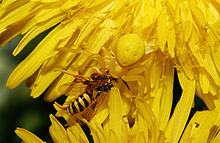- Misumena vatia
-
Goldenrod Crab Spider 
Goldenrod crab spider capturing a wasp Scientific classification Kingdom: Animalia Phylum: Arthropoda Class: Arachnida Order: Araneae Family: Thomisidae Genus: Misumena Species: M. vatia Binomial name Misumena vatia
(Clerck, 1757)Synonyms Araneus vatius
Aranea calycina
Aranea 4-lineata
Aranea kleinii
Aranea osbekii
Aranea hasselquistii
Aranea uddmanni
Aranea scorpiformis
Aranea virginea
Aranea citrea
Aranea citrina
Aranea sulphereoglobosa
Aranea sulphurea
Aranea quinquepuncata
Aranea albonigricans
Aranea calicina
Aranea cretata
Misumena citrea
Thomisus citreus
Thomisus calycinus
Thomisus dauci
Thomisus pratensis
Thomisus spinipes
Thomisus scorpiformis
Thomisus quadrilineatus
Thomisus viridis
Thomisus phrygiatus
Thomisus devius
Thomisus fartus
Thomisus vatius
Pachyptile devia
Thomisus cucurbitinus
Misumena oblonga
Misumena calycina
Misumena occidentalis
Misumenops vatiaMisumena vatia is a species of crab spider with holarctic distribution. In North America, where it is the largest and best-known flower spider, it is called the goldenrod crab spider or flower (crab) spider[1], because it is commonly found hunting in goldenrod sprays in the autumn.
Young males in the early summer may be quite small and easily overlooked, but females can grow up to 10 mm (excluding legs); males reach 5 mm at most.
Contents
Description
These spiders may be yellow or white, depending on the flower in which they are hunting. Especially younger females, which may hunt on a variety of flowers such as daisies and sunflowers, may change color "at will". Older females require large amounts of relatively large prey to produce the best possible clutch of eggs. They are therefore, in North America, most commonly found in goldenrod (Solidago sp.), a bright yellow flower which attracts large numbers of insects, especially in autumn. It is often very hard even for a searching human to recognize one of these spiders on a yellow flower.
Reproduction
The much smaller males scamper from flower to flower in search of females and are often seen missing one or more of their legs. This may be due either to near misses by predators such as birds or to fighting with other males.
When a male finds a female, he climbs over her head over her opisthosoma onto her underside, where he inserts his pedipalps to inseminate her.
The young reach a size of about 5mm by autumn and spend the winter on the ground. They molt for the last time in May of the next year.
Color change
These spiders change color by secreting a liquid yellow pigment into the outer cell layer of the body. On a white base, this pigment is transported into lower layers, so that inner glands, filled with white guanine, become visible. If the spider dwells longer on a white plant, the yellow pigment is often excreted. It will then take the spider much longer to change to yellow, because it will have to produce the yellow pigment first. The color change is induced by visual feedback; spiders with painted eyes were found to have lost this ability.
The color change from white to yellow takes between 10 and 25 days, the reverse about six days. The yellow pigments have been identified as kynurenine and 3-hydroxykynurenine[2]
-
Female Misumena vatia, on Achillea millefolium flowers
See also
References
- ^ Acorn, John and Sheldon, Ian. Bugs of Ontario, Edmonton: Lone Pine Publishing, 2003
- ^ Oxford, G.S. & Gillespie, R.G. (1998). Evolution and Ecology of Spider Coloration. Annual Review of Entomology 43:619-643. doi:10.1146/annurev.ento.43.1.619
External links
- Pictures of M. vatia on BugGuide.net
- Pictures of M. vatia (free for noncommercial use) (another one)
- Goldenrod crab spider Wildlife Goldenrod crab spider
Categories:- Thomisidae
- Animals that can change color
- Mimicry
- Animals described in 1757
- Spiders of Europe
-
Wikimedia Foundation. 2010.





